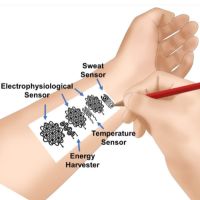A team of mechanical engineers and computer scientists at the University of Minnesota have developed a 3D printing technique that allows to print electronic sensors directly on organs that are expanding and contracting. Their work is reported in Science Advances.
You might also like:Pioneering Machine Learning Techniques in 3D Printing and Radiology
This breakthrough achievement builds on the team’s previous work. Two years ago they managed to print electronic tattoos directly on the skin of a moving nondeforming hand. The new in situ 3D printing system uses motion capture technology and enables more precise tracking to 3D print sensors on organs that change shape, such as the lungs or heart. The researchers printed a hydrogel-based electrical impedance tomography (EIT) sensor on a porcine lung under respiration-induced deformation.
The research suggested modelling the deformation of the target surface with the
help of using a shape basis model that could be learned from a dataset of 3D
scans. A set of fiducial markers tracked by a stereo camera system facilitated the
accurate recovery of the surface geometry, which was then used to dynamically
adapt the 3D printing toolpath in real time.
Process of in situ 3D printing of EIT sensor on a breathing lung. Schematic images of (A) 3D scanning of the lung surface, (B) real-time tracking of the breathing lung, (C) adaptive printing of the hydrogel ink on the breathing lung, and (D) in situ monitoring of lung deformation with the EIT sensor. (Source: Zhu et al. 2020)
This AI-powered system can adapt to the deformation and motion of the target surface and effectively estimate deformation in the form of a dynamic point cloud by combining ‘offline’ machine learning with ‘online’ computer vision-based tracking. The innovative design of a hydrogel-based EIT sensor for spatiotemporal mapping has several advantages, such as simplicity in sensor geometry, desirable sensing resolution and ideal mechanical compliance to soft tissues.
The authors argue that the new 3D printing technique could have many
applications in surgical robotics, such as printing electrode arrays for neural
interfaces and printing bioscaffolds with engineered cells for tissue
regeneration.
























